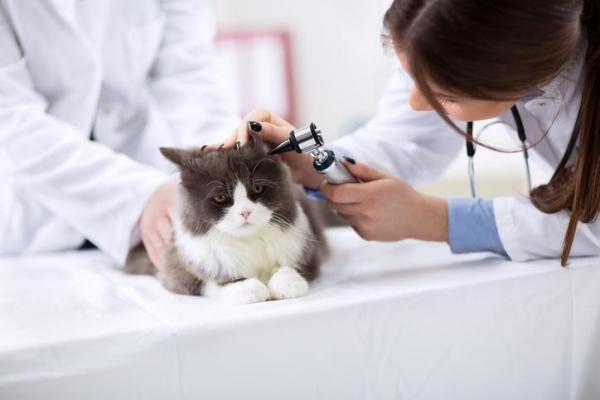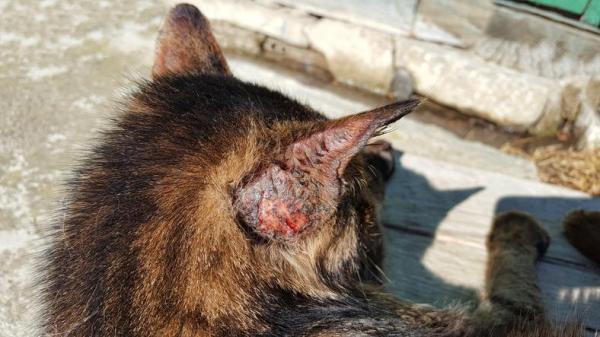Ear Problems In Cats



See files for Cats
Every animal has characteristics that naturally develop in order to aid it in living comfortably. Along with their great sense of vision, cats also have an acute sense of hearing. These senses help a cat manoeuver through their respective environments and communicate between each other and other beings. However, their ears can also suffer from various conditions, which can in turn, worsen their natural capacity and endanger a feline’s health. Therefore, as a cat owner, it is incredibly important to be able to recognize whether your cat is suffering from an ear infection or disease.
For this reason, in this AnimalWised article, we will be discussing the most common ear problems in cats. Keep reading to find out more about what they are and how to notice the symptoms.
Cat Ear Infection: Otitis
Otitis in cats is defined as an inflammation of the epithelium, the inner tissue of the ear that is responsible for protecting the auditory organ of external microorganisms. It is also reconfigured as a secreting substances. Otitis is a common ear infection which is very painful for cats. Otitis can also generate temporary loss of hearing in cats.
Its causes are diverse, from mites and bacteria to fungi or foreign bodies that have entered the auditory cavity. If your cat is suffering from otitis, it will scratch its ears frequently, shake its head and complain through constant meowing. If you believe that your cat is suffering from otitis, we suggest consulting a veterinarian. A professional will most likely prescribe the appropriate antibiotics, relevant to the specific causes.

Cat ear problems: mites
Notoedric mange in cats, is a type of scabies that affects both the ears and other parts of the feline's body. It is caused by the mite Notoedres cati, which nests on a cat’s skin, specifically on its head.
Notoedric scabies causes intense irritation in the ears, resulting in excessive scratching from a cat. This scabies can very often cause symptoms of ear redness, restlessness and scratching injuries. In the case of notoedric scabies, topical treatment is commonly prescribed. The use of pipettes, shampoo, or injectable medications are also sometimes recommended, depending again on the specific case.
Cat ear problems: external
Dermatophytosis, also known as ringworm, is a disease caused by dermatophytes, a type of fungus that normally affects a cat’s: head, legs and ears. It is very common in young cats, especially those that are less than one year old and those with long fur.
Among the symptoms of this common cat ear infection is pruritus, otherwise known as severe itching of the skin. Although this disease can disappear spontaneously, it is highly contagious to both animals and people, therefore it is recommended to treat it as soon as possible. Ointments and creams are commonly applied as treatment. In more serious cases oral medicines can be prescribed.

Cat ear problems: skin
Solar dermatitis in cats is a disease caused by constant and prolonged exposure to the sun. It appears when melanin in a cat’s coat is reduce, revealing a light color. Solar dermatitis is characterized by the appearance of crusts, ulcers and scaly skin on the ears. Therefore, if your cat has scabs or wounds on its ears, awareness needs to be taken. In extreme cases, tumors may appear. In addition to this, it causes severe pain and itching, so a cat will scratch frequently, causing injuries.
In terms of treatment, it is recommended to immediately suspend your cat’s sun exposure and place creams and ointments on the affected areas. In severe cases, surgery may be necessary.
cat ear problem: shaking head
Pemphigus foliaceus in cats is an autoimmune disease that attacks a feline’s head, specially its ears. An autoimmune disease is a disease in which the body of an affected animal destroys itself, as it stops differentiating between good and bad cells.
If your cat suffers from this disease, it will present: pustules, sores, loss of fur, itching, discomfort, lethargy and fever. This autoimmune disease is difficult to treat and if not treated in time, can result in the death of an animal. Treatment of pemphigus foliaceus includes ointment application on affected areas: accompanied by corticosteroids, immunosuppressants, biological therapies and antibiotics.
Cat ear problem: hair loss
Like pemphigus foliaceus, lupus in cats is an autoimmune disease that attacks the skin, concentrated mainly on a cat’s head. This disease specifically affects the nose, eyes and ears.
Symptoms of lupus in cats includes: fever, open wounds, loss of coloration of the affected area, hair loss and ulcers. There is no treatment that can completely eliminate this disease, therefore, a veterinarian will instead focus on reducing the conditions of the symptoms. In general, immunosuppressants, antibiotics and topical treatments are used to reduce the ailments suffered by the feline.
Cat ear hematoma
Cat hematoma affects the auditory pavilions a cat’s ears. It can be caused by sudden jerk of the head or by energetic scratching, often caused by mites. These actions accumulate blood in the pavilions, which end up inflamed. There are two treatments for this infection: the application of anti-inflammatories and/or surgery.
Caring for your cat’s ears
It is very important to maintain proper care when it comes to your cat's ears, as this prevents the appearance of any infection. We recommend that you periodically check the outer part of your cat’s ears to detect any: infection, inflammation, foreign secretions or objects that may have penetrated the cavity.
For cleaning, it is best to go to a veterinarian. A professional can clean your cat’s ears without there being any risk of damaging your cat's ear canal. However, we also recommend taking a look at our article on "Cleaning your cat’s ears: step by step guide".
Never apply medication or spray any liquid into your cat’s ears without medical supervision or recommendation. Keep in mind that many of these common ear infections in cats are serious. In some cases there is no treatment, therefore prevention is key.

This article is purely informative. AnimalWised does not have the authority to prescribe any veterinary treatment or create a diagnosis. We invite you to take your pet to the veterinarian if they are suffering from any condition or pain.
If you want to read similar articles to Ear Problems In Cats, we recommend you visit our Prevention category.








